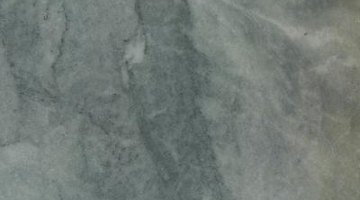Lime Buildup on Slate Tile
Slate tile lends a rustic, natural beauty to the home, and comes in a wide range of colors to fit any decor. While this material offers the strength and density typically associated with natural stone products, maintaining its rich coloring requires regular maintenance and care. In addition to everyday cleaning to remove dirt and dust, slate may also require more aggressive treatment to remove ugly lime deposits and other mineral stains.
Causes

Hard water, caused by minerals in the water, can leave deposits of calcium, magnesium and other minerals behind on faucets, tiles and other surfaces in your home. These mineral deposits, known as lime or limescale, can build up in your home, getting thicker over time. When limescale occurs within a faucet or pipe, it can prevent the flow of water and lead to plumbing problems. On slate tile, the effects of limescale are largely aesthetic.
Signs
Lime buildup on slate tiles leaves a white, scaly or chalky finish on the surface of the tiles. On sealed slate, wiping your finger across this buildup will leave a white residue or powder on your finger. Lime buildup is easily confused with efflorescence, which occurs when mineral salts in the tiles make their way to the surface. While lime sits above the sealer on slate tile, efflorescence remains trapped beneath the sealer, according to the Aldon Corporation. If you run your hand across sealed tile and no white residue comes off on your hand, you are likely dealing with efflorescence, not lime buildup. While these two types of stains can be removed using similar methods, removing efflorescence requires stripping the sealer off the tile prior to cleaning it.
Removal
Keep acidic cleaners, including acid-based cleaners, vinegar and lemon, far from slate floors to avoid damage. Choose a pH-neutral cleaner designed for use on slate tile, then test it in an out-of-the-way spot to make sure it doesn't discolor or otherwise damage the surface of the tile. Sweep the floor to remove dirt and debris, then apply the cleaner using a mop or sponge based on the manufacturer's recommendations. Agitate the cleaner using a stiff brush, focusing on areas where lime deposits are present, then rinse the slate using clean water applied with a mop or sponge. A wet vacuum can help you eliminate sludge from thick deposits of lime.
Prevention
Prevent lime buildup on slate tile by eliminating the sources of water on and around the tile. Fix leaky pipes and fixtures and repair any clogged or malfunctioning drains in the kitchen, bath or patio. Invest in a water softener to prevent lime buildup in showers and tub surrounds. These systems remove hard minerals from the water to eliminate or reduce limescale. Clean your slate tiles more frequently to keep lime from building up, and consider sealing unsealed floors to prevent lime deposits from adhering to the surface of the tile.
References
Writer Bio
Emily Beach works in the commercial construction industry in Maryland. She received her LEED accreditation from the U.S. Green Building Council in 2008 and is in the process of working towards an Architectural Hardware Consultant certification from the Door and Hardware Institute. She received a bachelor's degree in economics and management from Goucher College in Towson, Maryland.
Photo Credits
- Jupiterimages/Photos.com/Getty Images
More Articles



